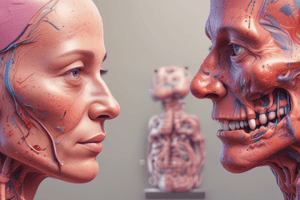Podcast
Questions and Answers
What is the proposed mechanism for malignant hyperthermia?
What is the proposed mechanism for malignant hyperthermia?
- Exposure to halogenated anesthetic agents leads to increased muscle relaxation due to increased release of Ca2+ from skeletal muscle sarcoplasmic reticulum, increased ATP production, decreased O2 consumption, CO2 production, and heat, resulting in membrane failure and leakage of K+, creatinine kinase, and myoglobin.
- Exposure to halogenated anesthetic agents leads to decreased muscle contraction due to release of Ca2+ from skeletal muscle sarcoplasmic reticulum, depletion of ATP, decreased O2 consumption, CO2 production, and heat, resulting in membrane failure and leakage of K+, creatinine kinase, and myoglobin.
- Exposure to halogenated anesthetic agents leads to decreased muscle relaxation due to decreased release of Ca2+ from skeletal muscle sarcoplasmic reticulum, decreased ATP production, increased O2 consumption, CO2 production, and heat, resulting in membrane failure and leakage of K+, creatinine kinase, and myoglobin.
- Exposure to halogenated anesthetic agents leads to increased muscle contraction due to release of Ca2+ from skeletal muscle sarcoplasmic reticulum, depletion of ATP, increased O2 consumption, CO2 production, and heat, resulting in membrane failure and leakage of K+, creatinine kinase, and myoglobin. (correct)
Which of the following anesthetic agents has NOT been found to cause malignant hyperthermia?
Which of the following anesthetic agents has NOT been found to cause malignant hyperthermia?
- Halothane
- Enflurane
- Desflurane
- Nitrous oxide (correct)
Which of the following muscle relaxants has been identified as a trigger for malignant hyperthermia?
Which of the following muscle relaxants has been identified as a trigger for malignant hyperthermia?
- Succinylcholine (correct)
- Nondepolarizing muscle relaxants
- Ketamine
- Propofol
Which of the following is NOT a risk factor for developing malignant hyperthermia?
Which of the following is NOT a risk factor for developing malignant hyperthermia?
Which of the following is the most appropriate initial treatment for a patient experiencing malignant hyperthermia?
Which of the following is the most appropriate initial treatment for a patient experiencing malignant hyperthermia?
Which of the following statements about the definition of malignant hyperthermia is INCORRECT?
Which of the following statements about the definition of malignant hyperthermia is INCORRECT?
Which of the following is the recommended treatment for outpatient pneumonia?
Which of the following is the recommended treatment for outpatient pneumonia?
What is the primary symptom of a urinary tract infection?
What is the primary symptom of a urinary tract infection?
Which of the following is NOT a symptom of a wound infection?
Which of the following is NOT a symptom of a wound infection?
What is the recommended diagnostic test for deep vein thrombosis (DVT)?
What is the recommended diagnostic test for deep vein thrombosis (DVT)?
Which of the following is NOT a potential cause of post-operative fever after 7 days?
Which of the following is NOT a potential cause of post-operative fever after 7 days?
What is the recommended diagnostic test for pulmonary embolism (PE)?
What is the recommended diagnostic test for pulmonary embolism (PE)?
Which of the following is NOT a clinical feature of malignant hyperthermia?
Which of the following is NOT a clinical feature of malignant hyperthermia?
What is the initial recommended dose of dantrolene for treating malignant hyperthermia?
What is the initial recommended dose of dantrolene for treating malignant hyperthermia?
Which of the following is the most common cause of postoperative fever on days 1-2?
Which of the following is the most common cause of postoperative fever on days 1-2?
Which of the following is a symptom of atelectasis?
Which of the following is a symptom of atelectasis?
What is the normal range for body temperature in postoperative patients?
What is the normal range for body temperature in postoperative patients?
Which of the following is the recommended treatment for malignant hyperthermia?
Which of the following is the recommended treatment for malignant hyperthermia?
Flashcards are hidden until you start studying




